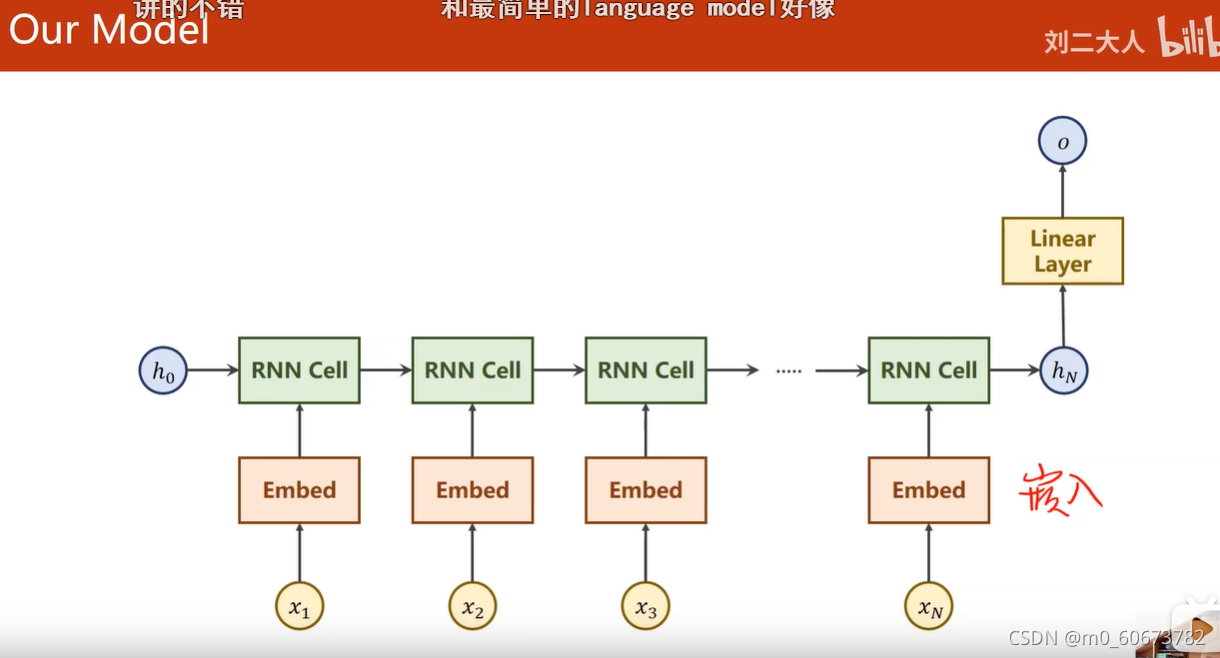用RNN做一个分类器~
- 根据名字来判断国家18个语言地区,几千个名字,训练模型,输入新名字,然后告诉我们是使用哪种语言的人
- 复习:oneho通过嵌入层,然后RNN层,隐状态~做线性层,把输出映射成我们要的维度

-
?hN是最后一个隐层
-
输入名字M c l e a n是一个序列,而且序列长短不一样
-
我们把嵌入层RNN 线性层 定义名叫RNNClassifier
-
主循环:
-

-
if __name__ == '__main__': #N_CHARS字符数量输入英文字母转换成onehot向量、隐层数量、country分类一共多少、layerGRU几层 classifier = RNNClassifier(N_CHARS, HIDDEN_SIZE, N_COUNTRY, N_LAYER) if USE_GPU: device = torch.device("cuda:0") classifier.to(device) #损失函数、优化器 criterion = torch.nn.CrossEntropyLoss() optimizer = torch.optim.Adam(classifier.parameters(), lr=0.001) #打印训练时间的长度 start = time.time() print("Training for %d epochs..." % N_EPOCHS) #recording the accuracy of testing acc_list = [] for epoch in range(1, N_EPOCHS + 1): # Train cycle 把训练和测试封装在两个函数里 trainModel() acc = testModel() acc_list.append(acc)还有一个函数:
-
#距离训练开始的时间,python中以秒为单位,除60变成分 def time_since(since): s = time.time() - since m = math.floor(s / 60) s -= m * 60 return '%dm %ds' % (m, s)1准备数据
- 名字的处理:
-
每个字符对应一个ASCII值0-127
-
序列长度不一样,做padding让他们变成一样长度
-
国家处理:
-
把国家名变成分类索引,从0开始索引标签~做一个对应的词典~
-
代码:
-
# Parameters HIDDEN_SIZE = 100 BATCH_SIZE = 256 N_LAYER = 2 N_EPOCHS = 100 N_CHARS = 128 USE_GPU = False #prepare data class NameDataset(Dataset): def __init__(self, is_train_set=True): #reading data frfom .gz file with package gzip and csv filename = 'data/names_train.csv.gz' if is_train_set else 'data/names_test.csv.gz' with gzip.open(filename, 'rt') as f: reader = csv.reader(f) rows = list(reader) #save names and countries in list self.names = [row[0] for row in rows] self.len = len(self.names) self.countries = [row[1] for row in rows] #save countries and its index in list and dictionary #sorted 去除重复的国家名 self.country_list = list(sorted(set(self.countries))) #根据列表 转成词典 self.country_dict = self.getCountryDict() self.country_num = len(self.country_list) # save countries and its index in list and dictionary def __getitem__(self, index): return self.names[index], self.country_dict[self.countries[index]] #return length of dataset def __len__(self): return self.len #convert list into dictionary def getCountryDict(self): country_dict = dict() for idx, country_name in enumerate(self.country_list, 0): country_dict[country_name] = idx return country_dict #根据索引返回国家名 def idx2country(self, index): return self.country_list[index] #得到国家的数量 def getCountriesNum(self): return self.country_nu trainset = NameDataset(is_train_set=True) trainloader = DataLoader(trainset, batch_size=BATCH_SIZE, shuffle=True) testset = NameDataset(is_train_set=False) testloader = DataLoader(testset, batch_size=BATCH_SIZE, shuffle=False) #N_COUNTRY is output size of our model N_COUNTRY = trainset.getCountriesNum()
?2模型设置
- 什么是Bi-direction RNN/LSTM/GRU
- 在自然语言中 考虑后文的词的影响
- forward沿着序列方向,反向一次,然后把正向反向的隐层做拼接~
- 输出:h0...hN
- hidden=[
]

?
?代码:
#model design
class RNNClassifier(torch.nn.Module):
def __init__(self, input_size, hidden_size, output_size, n_layers=1, bidirectional=True):
super(RNNClassifier, self).__init__()
#hidden size n——layers是GRU的参数
self.hidden_size = hidden_size
self.n_layers = n_layers
self.n_directions = 2 if bidirectional else 1
#The input of Embedding layer with shape (𝑠𝑒𝑞𝐿𝑒𝑛, 𝑏𝑎𝑡𝑐?𝑆𝑖𝑧𝑒)
#The ouput of Embedding layer with shape ( 𝑠𝑒𝑞𝐿𝑒𝑛, 𝑏𝑎𝑡𝑐?𝑆𝑖𝑧𝑒, ?𝑖𝑑𝑑𝑒𝑛𝑆𝑖𝑧)
self.embedding = torch.nn.Embedding(input_size, hidden_size)
#GRU层 bidirectional是用来说明是单向还是双向
self.gru = torch.nn.GRU(hidden_size, hidden_size, n_layers,
bidirectional=bidirectional)
#bidirectional之后要乘self.n_directions
self.fc = torch.nn.Linear(hidden_size * self.n_directions, output_size)
def _init_hidden(self, batch_size):
hidden = torch.zeros(self.n_layers * self.n_directions,
batch_size, self.hidden_size)
return create_tensor(hidden)
def forward(self, input, seq_lengths):
# input shape : B x S -> S x B transpose转置
input = input.t()
batch_size = input.size(1)
hidden = self._init_hidden(batch_size)
embedding = self.embedding(input)
# pack them up GRU中的提速功能
gru_input = pack_padded_sequence(embedding, seq_lengths)
output, hidden = self.gru(gru_input, hidden)
if self.n_directions == 2:
hidden_cat = torch.cat([hidden[-1], hidden[-2]], dim=1)
else:
hidden_cat = hidden[-1]
fc_output = self.fc(hidden_cat)
return fc_output
3convert name to tensor
- 把字符转变成一个字符,字符变成ASCII码,然后填充,转置,排序

def name2list(name):
arr=[ord(c) for c in name]
return arr,len(arr)
def make_tensors(names, countries):
sequences_and_lengths = [name2list(name) for name in names]
name_sequences = [sl[0] for sl in sequences_and_lengths]
seq_lengths = torch.LongTensor([sl[1] for sl in sequences_and_lengths])
countries = countries.long()
# make tensor of name, BatchSize x SeqLen
# 补零:先将所有的0yongtensor初始化,然后在每行前面填充名字
seq_tensor = torch.zeros(len(name_sequences), seq_lengths.max()).long()
# print("seq_lengths.max:", seq_lengths.max())
for idx, (seq, seq_len) in enumerate(zip(name_sequences, seq_lengths), 0):
seq_tensor[idx, :seq_len] = torch.LongTensor(seq)
# sort by length to use pack_padded_sequence
# 将名字长度降序排列,并且返回降序之后的长度在原tensor中的小标perm_idx
seq_lengths, perm_idx = seq_lengths.sort(dim=0, descending=True)
# 这个Tensor中的类似于列表中切片的方法神奇啊,直接返回下标对应的元素,相等于排序了
seq_tensor = seq_tensor[perm_idx]
countries = countries[perm_idx]
# 返回排序之后名字Tensor,排序之后的名字长度Tensor,排序之后的国家名字Tensor
return create_tensor(seq_tensor), \
create_tensor(seq_lengths),\
create_tensor(countries)4 训练数据
classifier = RNNClassifier(N_CHARS, HIDDEN_SIZE, N_COUNTRY, N_LAYER)
criterion = torch.nn.CrossEntropyLoss()
optimizer = torch.optim.Adam(classifier.parameters(), lr=0.001)
import time
import math
def trainModel():
def time_since(since):
s = time.time() - since
m = math.floor(s / 60)
s -= m * 60
return '%dm %ds' % (m, s)
total_loss = 0
for i, (names, countries) in enumerate(trainLoader, 1):
# print(type(names), type(countries))
# print(len(names), countries.shape)
inputs, seq_lengths, target = make_tensors(names, countries)
output = classifier(inputs, seq_lengths)
# print("Shape:", output.shape, target.shape)
# 注意输出和目标的维度:Shape: torch.Size([256, 18]) torch.Size([256])
loss = criterion(output, target)
optimizer.zero_grad()
loss.backward()
optimizer.step()
total_loss += loss.item()
if i % 10 == 0:
print(f'[{time_since(start)}] Epoch {epoch} ', end='')
print(f'[{i * len(inputs)}/{len(trainSet)}] ', end='')
print(f'loss={total_loss / (i * len(inputs))}')
return total_loss
def testModel():
correct = 0
total = len(testSet)
print("evaluating trained model ... ")
with torch.no_grad():
for i, (names, countries) in enumerate(testLoader):
inputs, seq_lengths, target = make_tensors(names, countries)
output = classifier(inputs, seq_lengths)
# 注意这个keepdim的使用,为了直接和target计算loss
pred = output.max(dim=1, keepdim=True)[1]
# 注意这个view_as 和 eq
correct += pred.eq(target.view_as(pred)).sum().item()
percent = '%.2f' % (100 * correct / total)
print(f'Test set: Accuracy {correct}/{total} {percent}%')
return correct / total
N_EPOCHS = 50
start = time.time()
print("Training for %d epochs..." % N_EPOCHS)
acc_list = []
for epoch in range(1, N_EPOCHS + 1):
# Train cycle
trainModel()
acc = testModel()
acc_list.append(acc)
训练结果:
Training for 50 epochs...
[0m 2s] Epoch 1 [2560/13374] loss=0.00895661092363298
[0m 4s] Epoch 1 [5120/13374] loss=0.007739758561365306
[0m 6s] Epoch 1 [7680/13374] loss=0.0069853457777450485
[0m 8s] Epoch 1 [10240/13374] loss=0.006530495395418256
[0m 11s] Epoch 1 [12800/13374] loss=0.006135637713596225
evaluating trained model ...?
Test set: Accuracy 4535/6700 67.69%
[0m 15s] Epoch 2 [2560/13374] loss=0.004228085093200207
[0m 17s] Epoch 2 [5120/13374] loss=0.0041014277492649855
[0m 19s] Epoch 2 [7680/13374] loss=0.004011582878107826
[0m 22s] Epoch 2 [10240/13374] loss=0.0038964587613008915
[0m 24s] Epoch 2 [12800/13374] loss=0.0038181920163333416
evaluating trained model ...?
......(中间省略若干)
[12m 46s] Epoch 49 [2560/13374] loss=0.00016357196727767587
[12m 49s] Epoch 49 [5120/13374] loss=0.0001682748734310735
[12m 51s] Epoch 49 [7680/13374] loss=0.00017566338913942067
[12m 54s] Epoch 49 [10240/13374] loss=0.0001776946208337904
[12m 57s] Epoch 49 [12800/13374] loss=0.00018831568930181676
evaluating trained model ...?
Test set: Accuracy 5627/6700 83.99%
[13m 2s] Epoch 50 [2560/13374] loss=0.00016892087151063607
[13m 5s] Epoch 50 [5120/13374] loss=0.00015529338124906645
[13m 7s] Epoch 50 [7680/13374] loss=0.00017500294488854707
[13m 11s] Epoch 50 [10240/13374] loss=0.00017692927776806754
[13m 14s] Epoch 50 [12800/13374] loss=0.00018558732335804962
evaluating trained model ...?
Test set: Accuracy 5613/6700 83.78%
?
?5可视化
import matplotlib.pyplot as plt
import numpy as np
epoch = np.arange(1, len(acc_list) + 1)
acc_list = np.array(acc_list)
plt.plot(epoch, acc_list)
plt.xlabel('Epoch')
plt.ylabel('Accuracy')
plt.grid()
plt.show()

?注意:本节没看完,实在看不懂了,所以后半程的代码参考另一个csdn大佬博客【PyTorch】深度学习实践 b站 第13讲RNN高级篇_像我这样的人-CSDN博客? 若有侵犯联系删除
?作业:
链接:Sentiment Analysis on Movie Reviews | Kaggle

?
?
?
?